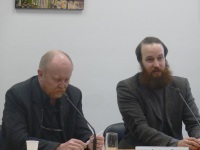Registration
You will receive an email confirming your registration.
IMGXYZ3125IMGZYXIn 2010, the overall security situation in the North Caucasus was worse than in 2009, although statistics show an improvement in some regions. Grigory Shvedov, editor-in-chief of the website Caucasian Knot, presented and discussed these statistics at a Carnegie Moscow Center event. Carnegie’s Alexey Malashenko moderated.
Republics Showing Improvement
- Chechnya: The situation in Chechnya improved in 2010. The number of blasts dropped 37 percent compared to 2009 (from 62 to 39), the number of suicide bombers dropped from nine to four, and casualties among the security forces decreased from 93 to 55. Chechnya’s leader, Ramzan Kadyrov, is pursuing an increasingly authoritarian strategy and using the principle of collective responsibility to punish insurgents and intimidate those who support them. This strategy has reduced the level of violence in Chechnya, but Shvedov noted that violence would start to rise again if this restraining force was loosened.
- Ingushetia: The situation in Ingushetia also improved in 2010. There were 40 blasts compared to 86 in 2009, two terrorist attacks carried out by suicide bombers compared to four in 2009, and 40 security force personnel killed compared to 92 in 2009. Unlike in Chechnya, the progress in Ingushetia represents a long-term improvement because the republic’s president, Yunus-Bek Yevkurov, is using a different strategy and different methods, Shvedov said. Instead of putting pressure on insurgents’ families and neighbors in order to discourage insurgents from taking action, authorities are attempting to engage radicals in dialogue. Shvedov regretted that other parts of the North Caucasus are not following Ingushetia’s strategy. The capture of insurgent leader Magas and the death of Said Buryatsky, both of whom were prominent figures in the radical opposition, also helped to stabilize the republic.
Republics Where the Situation Worsened
- Dagestan: This region saw an increase in violence in 2010. There were 112 blasts compared to 69 in 2009, a six-fold increase in the number of suicide bombers (from one to six), and 159 casualties among security forces personnel compared to 83 in 2009. Shvedov noted that the republic has recently established a commission to help the insurgents reintegrate into society; it aims to find a common language with the local radicals, engage them in dialogue, and draw them back out of the underground. Even if the commission’s work does not produce rapid results, its attempts to set dialogue with radicals could help in the long term, Shvedov said. A number of issues still need to be clarified, however: for example, clear procedures for amnesty need to be put into place, and federal authorities must decide whether they will support these procedures.
- Kabardino-Balkaria: This republic also saw more violence last year. The number of blasts in 2010 increased by 242 percent compared to 2009 (from twelve to 41). Shvedov noted that when the current head of the republic, Arsen Kanokov, came to power several years ago, he attempted to initiate dialogue with radicals and involve experts and peacefully minded Wahhabis in discussing the republic’s problems. This process, however, did not produce results and was halted.
Stavropol Territory
This region faces a possible increase in terrorism but has not adopted any targeted measures to improve the situation. In Shvedov’s view, experts believe the problem of the Nogai Jamaat Wahhabi group, which is active in the region, is more the product of journalists’ inaccurate information than indicative of the presence of a real organization. But it is possible that terrorists will become increasingly active in the region; presidential plenipotentiary envoy in the North Caucasus Federal District, Alexander Khloponin, resides here, while Islam radicals consider representatives of federal authorities as their enemies.
Trends and Outlook
- The vectors of terrorism: Shvedov noted that in 2010, the spread of terrorism had two different geographic directions: the first—toward Dagestan—and the second—toward Kabardino-Balkaria and the Stavropol Territory. This is worrying because the Stavropol Territory is close to Sochi, which will host the 2014 Winter Olympics and could become an enticing target for terrorists.
- Developing the North Caucasus Federal District: Last year also saw the approval of a long-term strategy to develop the North Caucasus Federal District both socially and economically, a plan drawn up at Khloponin’s direction. In Shvedov’s view, this strategy’s weak link is its absence of a strong security component. Khloponin takes a liberal position and seeks to replace security-based solutions for the North Caucasus’ problems with social and economic development—but after the attacks against tourists and ski-resort infrastructure in Kabardino-Balkaria earlier this year, Khloponin admitted there is a need for more effective security measures, recognizing that if the number of terrorist attacks increases, it would be very difficult to develop ski resort projects in Dagestan, for example. Other elements of Khloponin’s strategy, such as job creation, deserve more attention, Shvedov added.
- Region’s long-term outlook: Shvedov underscored that events in the North Caucasus in 2011 will be crucial for determining the region’s long-term fate. Decisions made at federal level will also play a big role. The worst-case scenario, he said, is that nothing in the region changes. In that case, the situation would continue to deteriorate and could result in conditions becoming so bad that even targeted measures no longer produce results, he concluded.
